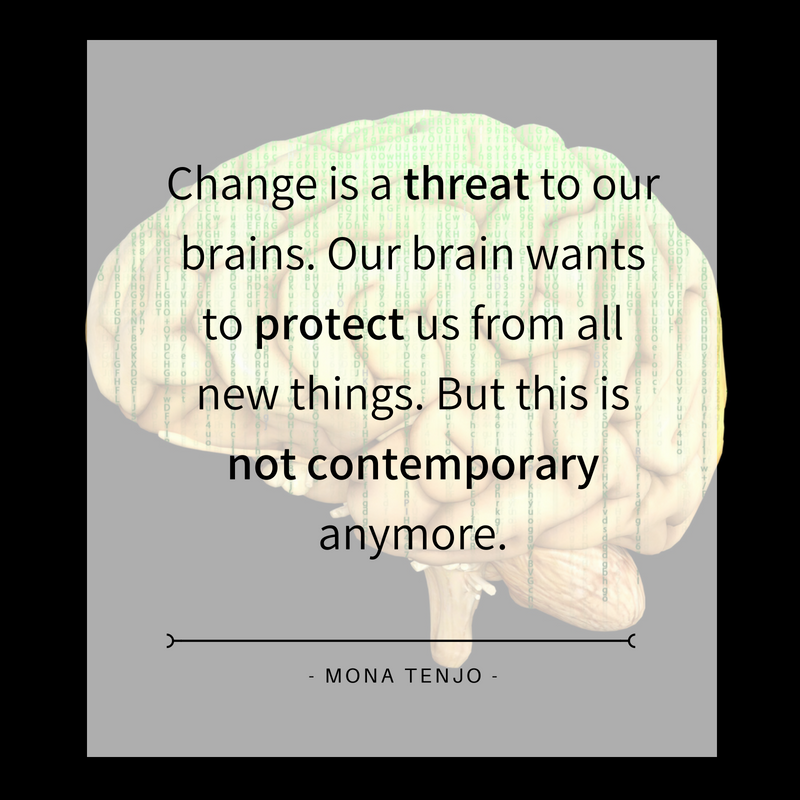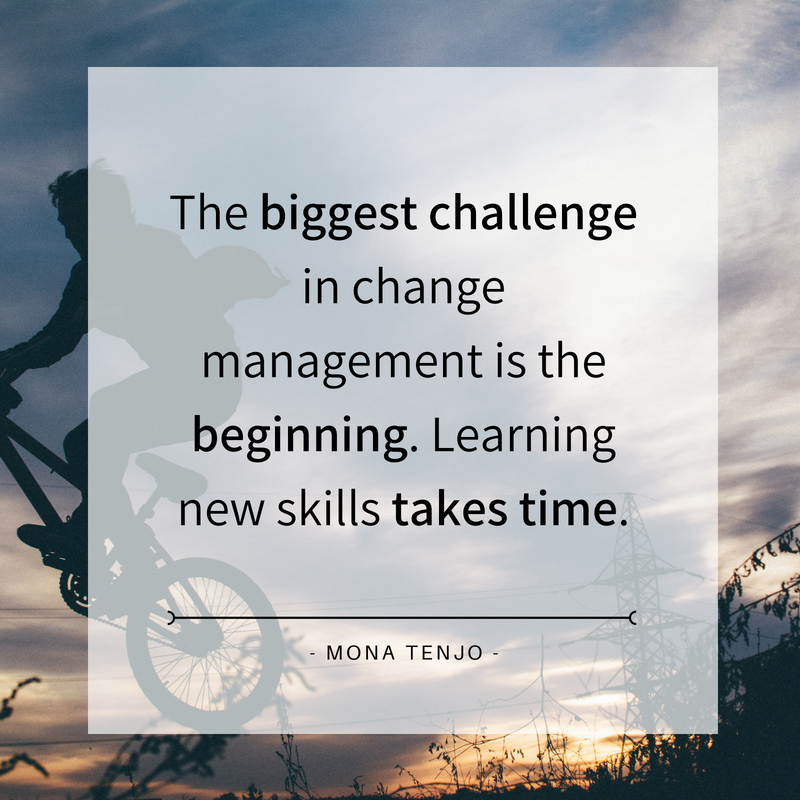Change Management – we all have heard this fancy term before. It means everything and nothing. But what is it really about and how do you get your people to change?
What is Change Management?
By definition, change management includes all measures and initiatives to adapt an organization to a changing environment. This comprises the adaption of enterprise strategies and organization structures. Some typical examples of change management are the re-organization of a service center, market expansion to a new geographical region or the introduction of a new software system. Whatever the challenge is, the process to implement this change is very similar.
Define the strategy, get the right people on board and execute the strategy. So far, so good. But now you track your results and realize that the change is not adopted as you intended. So, what to do?
What is the biggest challenge in Change Management?

It’s not a secret that the biggest challenge in change management is the people that have to change. We humans are creatures of habit. Every change is threatening us. Our brain prevents us to change because our brain likes routines. However, in today’s economy, not adapting to changes can ruin your company. Knowing that people are the key to successful change management, which is the best method to make change happen?
How to achieve change?
There are many publications and guides out on the market and you can obviously argue what the best way might be to get people to change. Of course, you should be transparent about the upcoming changes as this reduces the fear of unknown. If people don’t know where they shall go to, it makes them not move at all. This is a natural behavior which survived from ancient times, when making changes put our survival at risk. After knowing where to go, you need a clear strategy with defined action steps, KPIs to measure the progress, and regular reviews on the progress. You should lead by example and demonstrate the desired behavior. But what do you do if nothing helps? If there is no progress?
The Solution

I have executed software implementations all over the world, for different companies, on different levels and with different cultures. No matter the company, culture, or position in the company, there has always been resistance. In some companies less than in others, but people always try to get around new things.
What I have seen in various companies of different sizes, is the following: The only real, significant influence on the progress of Change Adaption, is the connection of compensation to the desired result. Yes, this might sound shocking to some of you, but it’s the reality. You can try talking to your people – I have seen organizations with such a great company culture that this is sufficient and delivers the desired results. However, this wouldn’t work for the majority of companies. For organizations that need to change fast and that have neither the time nor the knowledge to get their organization to adapt by itself, the only effective way is to tie the compensation to the results. People can suddenly be very open to adopt to and implement changes when their salary is at stake. It takes significantly longer to achieve the desired results, when there are no personal consequences for the ones involved. You can make it a part and priority for their bonus and objective review for example. Once the change has been implemented for a certain time, this point shouldn’t be a part of compensation requirements any longer.
Why is this effective?

Usually, the beginning is the most difficult part. It takes time to learn a new way of working. You need numerous repetitions until something new becomes natural. Especially in the beginning, people tend to go back to their old way of working, because it is faster and it’s been their habit for a while. Under time pressure, people tend to fall back into old behavioral patterns. When you introduce new technologies, people are skeptical. The only way to overcome this, is to convince them to apply it and increase their confidence in their own skills, until the promised results show. Employees have a high interest in their salary, so if parts of their compensation is tied to the new way of working, there is a real incentive for them to dig into it and try it. If, on top there’s a chance to even earn more if they adjust to the change, you will be surprised how fast the adaption will work.
Once again, trying to foster change and adaption through the monetary component alone, won’t be the most effective way. You need to talk to your employees to create an open atmosphere and lead by example. The monetary incentive has proved to be the most effective influence when it comes to motivating people to start the adaption of any change, but don’t forget that every change is still a team effort.
What’s your experience with Change Management?
Follow us on Instagram
More Articles Like This
Business Growth Fundamentals part 4: SETTING THE RIGHT MARKET PRICES WITH BOWMAN’S STRATEGY CLOCK
Do you know which options you have to position yourself price-wise? In this fourth part of the Business Growth Fundamentals Series, we will take a look at Bowman’s Strategy Clock. Bowman’s Strategy Clock is a model developed by Cliff Bowman and David Faulkner. It is...
Business Growth Fundamentals part 3: PORTER’S 5 FORCES
Are you wondering, why some industries just make more money than others? Are you wondering how you can also make more money in your industry? Read on to find out how to identify a good market with high profit margins. Michael D. Porter, a Harvard professor, invented...
Business Growth Fundamentals part 2: Business Growth with SWOT
Once upon a time, some 20 years ago in Finland, there was a huge company called NOKIA. NOKIA was one of the most profitable companies worldwide when it came to mobile phones. NOKIA? Mobile phones? Ask a 20-year old today which phone models NOKIA produced and they...





Thank you for the sensible critique. Me & my neighbor were just preparing to do some research about this. We got a grab a book from our area library but I think I learned more from this post. I am very glad to see such excellent info being shared freely out there.
Thank you very much for this great feedback! This is what we do the content for and it is amazing to see that it is valuable for you. Thanks a lot for sharing!
I am extremely impressed with your writing skills
and also with the layout on your weblog. Is this a paid theme or
did you customize it yourself? Either way keep up the nice quality writing, it’s
rare to see a great blog like this one nowadays.
Dear Elvira,
Thank you very much for your feedback! We really appreciate this as we put in a lot of work here 🙂
We are using a Divi Theme (I think the base version is a one-off of around 100$, but then you can use any theme available). We always start from a template and customize it from there.
Once again, thanks a lot for your feedback!
Have a wonderful day,
Mona
My brother recommended I might like this blog.
He was entirely right. This post truly made my day. You can not imagine simply how much time I had spent for this information! Thanks!
Thank you very much for this great feedback! And I am very happy to see that you find this information valuable. I condensed more than 15 years of hands on experience with change management and I am happy to see that you gained insights and saved yourself many years of though learning 😉
Have an amazing day!
Mona
Hey there! I know this is kind of off topic but I was wondering
which blog platform are you using for this
website? I’m getting fed up of WordPress because I’ve had problems with hackers and
I’m looking at alternatives for another platform. I would
be great if you could point me in the direction of
a good platform.
Dear Janina,
No worries, we also take such questions 😉
We are using WordPress with a Divi theme on top of it. WordPress offers great additional features for security, but honestly, I also don’t store any client data in WordPress directly but use separate systems for client data (e.g. payment data are stored in Stripe, Podia hosts my online courses, GetResponse has my email list). This way, these specialized companies save all my critical or sensitive data (and they have much bigger teams that only work on security). I only need to take care of my backups to make sure I can restore my page in case of an attack 🙂
I hope this helps.
Bye, Mona
Hi there everybody, here every one is sharing
such experience, thus it’s good to read this weblog,
and I used to visit this blog all the time.
Thank you very much for this great feedback! We truly appreciate it. It is hard work to create original content without just copy-pasting from others. We try to keep up the high quality 🙂
Every weekend i used to pay a visit this site, for the reason that
i wish for enjoyment, for the reason that this this site conations truly
nice funny data too.
Thank you! This is great to hear! Keep tuning in, we have great stuff to come 🙂
“Enjoyed every bit of your blog.Thanks Again. Great.”
Thank you very much! We’ll be posting new content very soon. Working on some really cool stuff 🙂
I used to be able to find good info from your blog articles.
Dear Christopher,
We keep adding content also on Facebook and Instagram but we will also start adding content here in this blog again.
Thanks a lot for your feedback!
Hiya very cool site!! Man .. Excellent .. Superb .. I’ll bookmark your site and take the feeds additionallyKI’m satisfied to seek out so many useful info here in the submit, we want develop more techniques on this regard, thanks for sharing. . . . . .
Thank you very much for this great feedback! We wil definitely add more content on people management 🙂
There is certainly a lot to know about this subject.
I love all the points you made.
Thank you very much, Jayson! Indeed, this topic is huge for every organization but also for every person. Change is something we all have to deal with.
I think this is a real great blog post.Thanks Again. Will read on…
Thank you very much! I highly appreciate your feedback!
What’s up friends, its great article concerning tutoringand fully explained, keep it up
all the time.
Thank you very much! Will do 🙂
Wow, marvelous blog layout! How long have you been blogging for?
you made blogging look easy. The overall look of your site is great, as well as the content!
Thank you very much! We are blogging for around 3 years for various projects. I think, you will find your personal style the more you write. And once you found “your voice”, it flows naturally 🙂
Wonderful goods from you, man. I’ve understand your stuff previous to
and you’re just too excellent. I actually like what you
have acquired here, really like what you’re saying
and the way in which you say it. You make it enjoyable and
you still take care of to keep it sensible. I can’t wait to read much more from you.
This is really a great web site.
Thank you very much for this great feedback! We’ll try to keep it up that way!
Hi there, yup this article is really fastidious and I have learned lot of things from it regarding
blogging. thanks.
Great, thanks a lot for this feedback!
This info is priceless. Where can I find out more?
Dear Oren, Thanks a lot! We post here as well as on Instagram and Facebook. We recently started with our membership area on how to work strategically on your business. You can learn more about this one here:
https://work-on-your-business.com/artofdelegation
This membership area comes with coaching sessions and tons of material on time management, delegation and people management as well as systems and processes. We constantly add to this membership to support freelancers and business owners in building a sustatinable business for the long run.
You can also send us a message to contact@respectstrategy.com for setting up a call if you want to discuss face-to-face.
Looking forward to hearing from you!
Mona from RespectStrategy